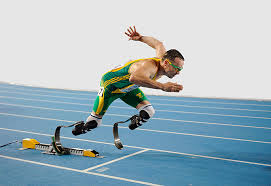Oscar Pistorius is one of the most polarizing figures in modern sports history. Once celebrated as a groundbreaking Paralympian who defied physical limitations, his legacy has since been overshadowed by a tragic and highly publicized criminal case. Still, his athletic impact particularly in terms of inclusion and technological debate in sport remains significant.
Before the controversy, Pistorius was not just a symbol of perseverance; he was a symbol of possibility.
Born Without Limits
Oscar Pistorius was born in 1986 in South Africa with a rare congenital condition: fibular hemimelia the absence of the fibula bones in both legs. At just 11 months old, both legs were amputated below the knee. But from the beginning, Pistorius defied expectations.
He participated in multiple sports as a youth including rugby and water polo but ultimately found his calling in sprinting. With the aid of carbon-fiber prosthetics, commonly referred to as “blades,” Pistorius began competing in track events and quickly made a name for himself.
Blurring the Line: Able-Bodied vs. Para-Athlete
Pistorius’s rise was meteoric in the Paralympic world. He won gold medals in the 100m, 200m, and 400m at the 2008 Beijing Paralympics. But what made his journey historic was not just his success among para-athletes it was his challenge to compete against able-bodied athletes on the world stage.
In 2012, Pistorius made global headlines when he qualified for and competed in the London Olympic Games, becoming the first double-amputee athlete to participate in Olympic track and field. Running on his signature “Flex-Foot Cheetah” blades, Pistorius competed in both individual and relay events.
Though he did not medal, his participation was monumental. He became known as the “Blade Runner,” a nickname that captured both his futuristic equipment and his role in running ahead of his time.
Technological Ethics and the Debate He Sparked
Pistorius’s presence in able-bodied competition triggered a debate that still echoes today: Do prosthetics provide an unfair advantage? The International Association of Athletics Federations (IAAF) initially banned him from competing, citing concerns that his blades gave him more energy return than a human ankle.
That decision was later overturned by the Court of Arbitration for Sport, which ruled there was insufficient evidence to prove an advantage. The case forced sports science, regulators, and the public to confront the evolving relationship between human ability and technology in elite sport.
His challenge blurred the line between natural and artificial performance raising questions not just about fairness, but about how we define athleticism itself.
Fall from Grace: The Tragedy That Rewrote His Legacy
In 2013, Pistorius was arrested for the fatal shooting of his girlfriend, Reeva Steenkamp. The incident, which took place in his Pretoria home, shocked the world. Pistorius claimed he mistook her for an intruder, but after a lengthy and highly public trial, he was eventually convicted of murder and sentenced to prison.
The case became one of the most closely followed criminal trials in South African history, and it irrevocably changed public perception of Pistorius. Once seen as a hero of resilience, he became a cautionary tale a reminder of how fame, trauma, and personal darkness can collide.
A Complicated Legacy
Oscar Pistorius is no longer viewed through a singular lens. For many, his name is synonymous with tragedy. For others, his athletic achievements remain worthy of recognition, particularly for what they meant to the disabled community and to the conversation around inclusivity in sports.
His career sparked essential debates about the definition of fairness, the role of technology in athletics, and the physical boundaries of human performance. Even in disgrace, his impact on sport especially Paralympic sport endures.
Oscar Pistorius is not a simple figure. He was a barrier-breaker and a world-record holder. He was also a man who committed an irreversible act of violence. His life, like his legacy, is marked by both extraordinary triumph and profound tragedy.
What remains clear is that Pistorius changed the landscape of athletics not just by competing, but by challenging the world to rethink what’s possible, and what’s fair, in the ever-evolving intersection of sport, science, and humanity.

